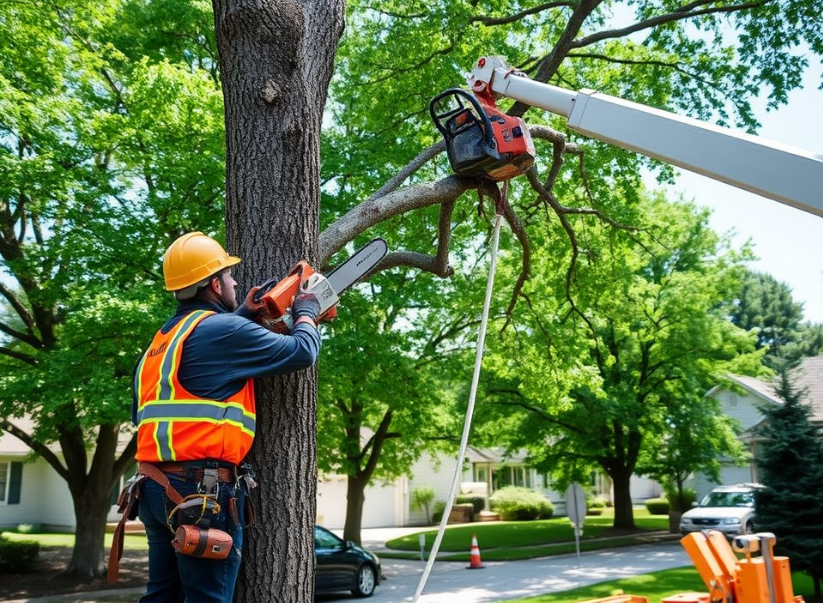Tree removal is a significant task that requires careful planning, expertise, and the right equipment. Whether a tree is dead, diseased, or simply in the way, tree removal services are essential to ensure the job is done safely and efficiently. In Fort Wayne, where trees are a cherished part of the landscape, gaining a clear understanding of the tree removal process can help you make informed decisions and protect your property. In this blog, we’ll walk you through the steps involved in professional tree removal services while also explaining why hiring experts is the best choice.
Key Takeaways
- Assessment: First, a professional evaluation determines if removal is necessary.
- Planning: Next, proper planning ensures the removal is safe and efficient.
- Equipment: Additionally, specialized tools and machinery are used for safe tree removal.
- Safety: Moreover, professionals follow strict safety protocols to protect people and property.
- Cleanup: Finally, the area is cleared of debris, leaving your property clean and tidy.
Why Is Professional Tree Removal Important?
Tree removal is not a DIY job. It involves risks such as falling branches, property damage, and personal injury. Professional tree removal services in Fort Wayne ensure the process is handled safely, efficiently, and with minimal disruption to your property. Additionally, experts can assess whether a tree needs to be removed or if other solutions, like trimming or treatment, might be more appropriate.
The Tree Removal Process: Step by Step
1. Initial Assessment

The first step in any tree removal service is a thorough assessment by a certified arborist.
- Evaluate the Tree’s Condition: The arborist checks for signs of disease, decay, or structural instability.
- Determine the Need for Removal: Not all problematic trees need to be removed; in some cases, trimming or treatment can save the tree.
- Plan the Removal: If removal is necessary, then the arborist will create a detailed plan, considering factors like tree size, location, and nearby structures.
2. Obtaining Permits

In Fort Wayne, some tree removals require permits, especially for protected or heritage trees.
- Check Local Regulations: Your tree removal services provider will handle the permit process, ensuring compliance with local laws.
- Avoid Fines: Removing a tree without the proper permits can result in hefty fines.
3. Preparing the Site

Before the removal begins, the site must be prepared to ensure safety and efficiency.
- Clear the Area: Remove any obstacles, such as furniture, vehicles, or garden decorations.
- Set Up Safety Zones: Establish barriers to keep people and pets at a safe distance.
- Protect Surrounding Structures: Use protective measures to safeguard nearby buildings, fences, or other trees.
4. Tree Removal

The actual removal process varies depending on the tree’s size, location, and condition.
- Climbing and Cutting: For smaller trees, arborists may climb the tree and cut it down in sections.
- Using Cranes or Heavy Machinery: For larger trees or those in tight spaces, cranes or specialized equipment may be used.
- Stump Removal: After the tree is cut down, then the stump can be ground down or removed entirely, depending on your preference.
5. Cleanup and Debris Removal

A professional tree removal services team will ensure your property is left clean and tidy.
- Remove Branches and Logs: All debris is cleared from the site.
- Chip or Haul Away Wood: Depending on your preference, wood can be chipped for mulch or hauled away.
- Restore the Area: The site is cleaned up, and any disturbed soil or grass is restored.
Why Hire Professional Tree Removal Services?
Attempting to remove a tree on your own can be dangerous and costly. Here’s why hiring professionals is the best choice:
- Safety: First, professionals have the training and equipment to handle tree removal safely.
- Efficiency: Experienced teams can complete the job quickly and effectively.
- Expertise: Certified arborists can assess the tree and recommend the best course of action.
- Insurance: Moreover, reputable tree removal services are fully insured, protecting you from liability.
Conclusion
Tree removal is a complex process that requires expertise, careful planning, and the right equipment. Therefore, by hiring professional tree removal services in Fort Wayne, you can ensure the job is done safely, efficiently, and with minimal disruption to your property. Whether you’re dealing with a dead tree, a hazardous limb, or a tree that’s simply in the way, you can trust the experts to handle the job with precision and care.
If you need reliable tree removal services in Fort Wayne, contact us today. Our team of certified arborists is here to help you with all your tree care needs!

